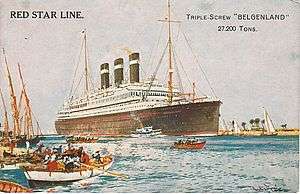SS Belgenland (1914)
The Belgenland was built in 1914 and originally served as a freighter and World War I troopship for the White Star Line under the name SS Belgic. Because she was needed for the war effort, she was hastily finished with only two smokestacks and a superstructure only one deck high. Initially used for carrying cargo, in 1918 she was given accommodations for up to 3,000 troops. Her gross tonnage was listed at 24,547. The doomed liner Justicia was a near identical sister ship, both being built at the same yard.
 Postcard of SS Belgenland | |
| History | |
|---|---|
| Name: |
|
| Owner: |
|
| Ordered: | 1914 |
| Builder: | Harland & Wolff, Belfast |
| Yard number: | 391 |
| Laid down: | 1912 |
| Launched: | 31 December 1914 |
| Christened: | 1919 |
| Completed: | 21 June 1917 |
| Commissioned: | 21 June 1917 to British government as troopship |
| Decommissioned: | 1936 |
| Maiden voyage: | 17 March 1923 |
| In service: | 1924 |
| Out of service: | 1935 |
| Refit: | 1922 |
| Stricken: | 1936 |
| Homeport: | Antwerp |
| Fate: | Scrapped 1936 at Bo'ness, Scotland |
| Notes: | Sister ship of the SS Justicia |
| General characteristics | |
| Class and type: | Justica Class |
| Tonnage: | 28,132 gross tons |
| Length: | 697 ft (212 m) oa, 670 ft (200 m) bp |
| Beam: | 78 ft 4 in (23.88 m) |
| Decks: | 9 |
| Propulsion: | Triple Expansion plus low pressure turbine by builders; Triple Screw; 18,500 IHP |
| Speed: | 18.5 knots (34.3 km/h; 21.3 mph) |
| Capacity: | 2,500 passengers |
| Notes: | 3 funnels, 2 masts |
Conversion to luxury liner
Originally ordered as the Bergenland for the Red Star Line but taken over during construction for use as a cargo vessel by the Shipping Controller and operated by the White Star Line who renamed her Belgic, the fourth ship to carry the name. In 1918 she was converted for use as a troopship able to carry 3000 troops. After the war she was employed returning US soldiers across the Atlantic until April 1921, when she was laid up at Liverpool.[1] There were no berths available at any of the shipyards so that she could be rebuilt. Harland & Wolff finally had a free berth, and in March 1922 she was towed to Belfast, where work on her reconstruction began in earnest.
She was allocated to the Red Star Line and renamed Belgenland. She was the second Red Star ship to be given this name. She was given a superstructure four decks in height and a third smokestack. Additionally she was converted to oil-firing.[1] Her tonnage was increased to over 27,000 gross tons, making her Red Star’s largest and most luxurious ship. She remained on her route for a decade, and occasionally spent time on extensive world and winter cruises.
On 4 December 1924 she embarked on a 133-day world cruise — one of the longest attempted by a luxury liner at the time - advertised as "The Largest Ship to Circle the Globe".

One of her most famous passengers was Albert Einstein. Returning to Germany on board her in 1933, he found out Adolf Hitler had become Chancellor of Germany. Einstein left the ship at Antwerp and renounced his German citizenship. Later he booked a passage from Dover on another Red Star liner, the Westernland, and returned to the United States, vowing never to return to Germany.[2]
Also in the 1920s, White Star line stewardess, Violet Jessop, famous for surviving the RMS Titanic and HMHS Britannic sinkings, sailed on Belgenland on two round the world cruises while employed by Red Star.
The Depression and demise
The Depression hit the Belgenland hard. At first, she was reduced to sailing on short cruises and one day excursions from New York, charging $4 a passenger. Laid up in the winter of 1932-33, she made only three voyages the following summer, and they were Mediterranean cruises. The millionaires who took her lengthy and expensive cruises were now unable to do so. Then she made a few more cruises from London, and then she was laid up again in September at the Port of London.
The Atlantic Transport Company purchased her in January 1935 and renamed her Columbia. She was then placed with their subsidiary, Panama Pacific Line and placed on their New York City — California service via the Panama Canal. This venture failed and another attempt was made to place her on the New York – West Indies route, stopping at Miami, Nassau, and Havana, but this too failed. She was too large for either service and was once again laid up, this time permanently.
On 22 April 1936 she sailed from New York to the United Kingdom, was sold for scrap, and her scrapping commenced on 4 May of that year at Bo'ness Scotland.[3]
References
- "White Star Liners" (PDF). Dieselduck.net. Retrieved 20 October 2019.
- http://www.shapell.org/manuscript/einstein-renounces-german-citizenship-becomes-outlaw-in-nazi-germany
- Frank C. Bowen The Shipbreaking Industry.
Further reading
- The First Great Ocean Liners in Photographs, 1897–1927, by William H. Miller
- Pictorial Encyclopedia of Ocean Liners, 1860–1994, by William H. Miller
- Cruising Ships, W.H. Mitchell and L.A. Sawyer, Doubleday, 1967
External links
| Wikimedia Commons has media related to Belgenland. |